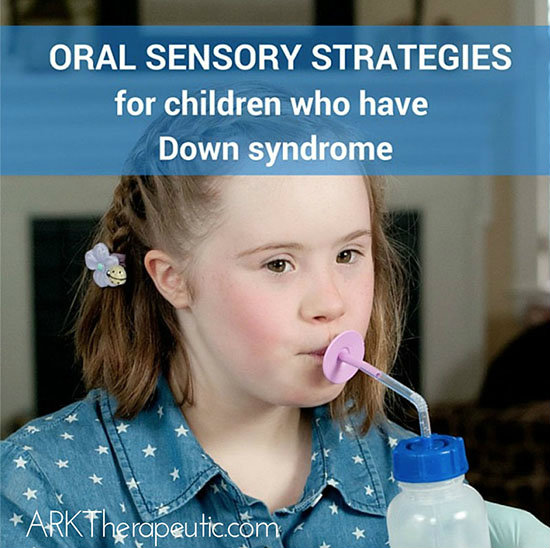Oral Sensitivities and Low Tone in Children with Down Syndrome
Posted by Debra C. Lowsky, MS, CCC-SLP on 11th Dec 2013
Question: I have a 12 day old infant with diagnosed Down Syndrome. She has moderate tongue protrusion. A friend suggested your products. I was wondering which ones you recommend and any suggestions you might have? Thank you for your help with this!
.

.
Dear New Mom, although each child is different, there are several goals that I usually work on:
.
ORAL SENSITIVITIES
In my experience, children who have Down syndrome often develop oral defensiveness and texture aversions, which can significantly impact their diet and ability to eat. So it's important to work on normalizing these sensitivities if they're already present. Or even better - to work preventatively before they start. There are several things you can do:
• As early as possible, get into the mouth to provide stimulation and introduce new textures. Use the Oral Motor Probe and proPreefer to stroke and apply gentle pressure to the gums, palate, cheeks, lips, and tongue. Stroke the sides of the tongue, run the tools across the tongue, inside the cheeks, over the lips, etc. For infants and toddlers, the proMini is a smaller version of the Probe designed to fit inside their little mouths. These therapy tools have different textures on them to provide a varied sensory experience. You can also dip them in food to introduce texture into mealtimes and for nutritive stimulation. Sticky foods work well, such as applesauce, yogurt, and stage 2 baby foods.
• Gum massage is a wonderful and incredibly effective way to provide input to all areas of the mouth. You can do this with your finger alone (just make sure your fingernails are short).
• Encourage mouthing/chewing on chew tools to introduce new sensations in the mouth. As early as 4-6 months, you can give her a Baby Grabber or Baby Guitar to chew on - these have an extension that will provide input to the back of her gums.
• When you start spoon feeding (usually around the age of 6 months), use textured spoons to introduce texture. The Small Textured Spoons are great starter spoons for tactile input. The Z-Spoon also has an option for a textured spoon tip. It has a smooth, gentle vibration that helps "wake up" the mouth during mealtimes and helps with sensory defensiveness and developing tone. (Not all people like vibration, so please know that you by no means have to use it and shouldn't force it.)
• Continue to introduce texture and provide oral input throughout her life. Just because she doesn't have sensitivities yet (or the sensitivities have gotten better), that doesn't mean you should stop. For example, if one of my therapy kids goes for a long period without seeing me (and mom and dad aren't doing homework with her), she becomes sensitive and orally defensive again.
• For more information on this topic, see this blog post on oral defensiveness.
.
GLOBAL SENSITIVITIES
It's also important to introduce new textures outside of the mouth. When one of my therapy kids was very young, she had sensitivities on her feet, and trouble walking because of it. I went to the fabric store and bought a variety of fabrics with different textures (samples/strips are fine). Then I ran the textures along her arms, hands, feet, and especially the soles of her feet, and she gradually became more comfortable with different sensations. Look for tactile toys and sensory play items that provide texture and stimulation and check Pinterest for sensory activity ideas.
.
LOW ORAL MUSCLE TONE
Much like any other muscle in the body, the mouth muscles must be toned and taut to perform certain skills, such as lip closure, tongue retraction, tongue elevation, tongue lateralization, jaw grading, etc. Opening the jaw for various speech sounds, lifting the tip of the tongue to pronounce l/t/n/d/s/z sounds, forming food into a bolus to swallow, retrieving leftover food particles from the lips and cheeks - all of these oral motor skills require a level of control, coordination, and oral tone. Children who have Down syndrome are often born with low oral muscle tone, and so you may in turn see difficulties with speech and feeding. Low oral tone can also contribute to drooling, weak suck, tongue protrusion, etc.
• There are many ways you can work proactively here. In addition to helping with sensitivities, the Baby Grabber and Baby Guitar provide a gentle workout for the lips, tongue, and especially the jaw. At the age of 3 years, she can "graduate" to the Y-Chews and regular Grabbers.
• When she's old enough to follow and understand directions, oral motor therapy is a great way to build oral tone, coordination, and dexterity. We have several blog posts on this topic from fun oral motor activities to activities with lollipops to exercises with the Z-Vibe.
• Once she's learned oral motor skills, I recommend monitoring them every so often, perhaps every 3-6 months. In my experience, mouth muscles can lose their tone and before you know it, bad habits tend to creep back. I've been seeing one child for the past 11 years, and if I ease up on the oral motor exercises for too long, she doesn't chew her food well, her tongue carriage becomes low and forward in the mouth, etc. The tongue is a muscle like any other. If I don't do my sit ups on a regular basis, for example, well you know :)
.
WEAK SUCK
Low oral tone can also cause drinking/sucking problems. If your infant has a weak suck, you can place the tip of the proPreefer in between lips and pull it in and out to stimulate a suck. I have personally never been in the NICU, but other speech therapists have told me that this works for them. .
Use the Bear Bottle to help her learn to drink from a straw - it comes with a special valve that keeps the straw full of fluid for babies with a weak suck. You squeeze the liquid to the top of the straw to start. Once she can suck from that height, you'll squeeze it to a slightly lower height the next time, repeating until she can suck liquid all the way up the straw. Consult this blog post on how to teach straw drinking.
.
TONGUE PROTRUSION
Tongue protrusion directly correlates with oral tone. If the tongue is not toned enough, it will rest low and forward in the mouth. The jaw must also be strong enough to hold itself in an almost closed position (teeth almost touching but not quite). The upper and lower lips must meet to stay closed as well. Building oral tone as mentioned above will help, and we also have a post on building jaw strength.
• Sinus congestion will work against you here, as children who have Down syndrome often have upper respiratory problems. If you can't breathe out of your nose, you're forced to have an open-mouth posture, which encourages the tongue to fall forward. Of course it's hard to avoid getting sick, but you can try working with your pediatrician to keep colds at bay.
• The BEST thing for tongue protrusion is to get children on straws as soon as possible, which is usually around 10 months of age. Try not to use sippy cups, as most of them promote bad oral posture and actually encourage tongue protrusion. Instead, use the Bear Bottle to transition straight from bottle to straw.
• Straws just by themselves are wonderful, but to get the most mileage out of them you'll want to also use a Lip Blok. These mouthpieces encourage correct oral posture and naturally work the mouth muscles to keep the tongue tight and retracted, the lips pursed and rounded, and the cheeks taut (see how the lips and cheeks are working in the picture above).
.
I also highly recommend the book Nobody Ever Told Me (or my Mother!) that by Diane Bahr. She walks you through each developmental stage, what to look for, and strategies for success. The Source for Down Syndrome by Catherine E. Chamberlain and Robin M. Strode is also FABULOUS, but unfortunately out of print. You may be able to find it on eBay.
Most importantly, I also recommend finding a speech therapist as soon as possible to help guide you through your daughter's development. I've started working on feeding therapy, texture issues, etc. as early as 2 months old, but oral stimulation can start even earlier.
Just do the best you can, following through with home suggestions from your therapist and also your instinct. It is certainly difficult in the beginning because your baby didn't come with instructions. Please remember that she has the capability to grow and change and be able to do so throughout her lifetime, not just when she is young. And you and your family must be very special people to be given a child who will change your lives in ways you can't even imagine.
.
All my best,
Debbie
Debra C. Lowsky, MS, CCC-SLP
.

